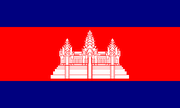This is a cool and cute Chinese singer called Karen Kong singing many sweet songs.
Friday, November 30, 2007
Saturday, November 17, 2007
New Book Available now!

This is the second Mathematical book I have prepared and designed for new Cambodian generation who like Mathematics the most and wanna become one of the top ten in the National Level and International Level. It includes many key strategies and Mathematical Competition in the world. Note: It is not mean that I have done this book, but I am doing this book....
And these are some Math exercises in this book:
1) p(x) and q(x) are polynomials of real coefficients that have no real roots in common, and p(q(x))=q(p(x)) for all x. Prove that the polynomials p(p(x)) and q(q(x)) have no common real roots either.
2) In Dragon Castle, 14-headed baby dragon is sleeping while mummy dragon is making pancakes. She lays them on a plate and leaves home. One head wakes up, eats 1/11 of the pancakes and falls asleep again. Then another head wakes up, eats 1/13 of the remaining pancakes and falls asleep again. Next, three heads wake up at the same time, eat 1/14 of the pancakes each, and finally they wake up the rest of the heads, too. Those who have eaten, do not get any more pancakes, the remaining 9 heads eat them all. (They do not necessarily eat the same number.) How many pancakes may have been on the plate, given that every head ate a whole number of pancakes, and if they had shared them equally, no one would have got more than 143?
3) Let ANC, CLB and BKA be triangles erected on the outside of the triangle
ABC such that \NAC = \KBA = \LCB and \NCA = \KAB = \LBC.
Let D,E,G and H be the midpoints of AB,LK,CA and NA respectively.
Prove that DEGH is a parallelogram.
4) Determine all positive integers a such that
Sn = fpag + fpag2 + ¢ ¢ ¢ + fpagn
is rational for some positive integer n. (For real number x, fxg = x ¡ bxc, where bxc denote
the the greatest integer less than or equal to x.)
5) Let n be a given integer with n greater than 7, and let P be a convex polygon with n sides.
Any set of n¡3 diagonals of P that do not intersect in the interior of the polygon determine
a triangulation of P into n ¡ 2 triangles. A triangle in the triangulation of P is an interior
triangle if all of its sides are diagonals of P.
Express, in terms of n, the number of triangulations of P with exactly two interior triangles,
in closed form.
6) A network of connections among n points is given, such that there is at
least one path connecting any two points. Furthermore each edge in this
network is assigned a positive real number, called its weight. The weight
of a path is defined as the maximum weight of any edges belonging to
the path. For any two vertices x and y define f(x, y) to be the minimum
weight among all the paths connecting x and y. Show that {f(x, y) :
x and y points in the network} has at most n − 1 elements.
Hope all of you who like math will share your ideas regarding these problems. And if you wanna give me some comments, you are more than welcomed to do.
Subscribe to:
Posts (Atom)





